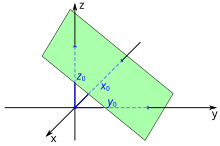Intercept shape
In mathematics, the intercept form is a special form of a straight line equation or plane equation . In the case of the axis intercept form, a straight line in the Euclidean plane or a plane in Euclidean space is described via its points of intersection with the coordinate axes . These intersection points are also called track points , their connecting lines in a plane generally lie on the straight track and form the track triangle . The intercept shape is a special implicit representation of the straight line or plane. It is not defined if the straight line or plane contains the origin of the coordinates .
Intercept form of a straight line equation
presentation
In the intercept form, a straight line in the plane is described by two real numbers and, as follows, by a linear equation . A straight line then consists of those points whose coordinates the equation
fulfill. Here and are the points of intersection of the straight line with the two coordinate axes , which are also referred to as track points . If the equation is solved for , it results
- ,
where the ratio corresponds to the slope of the straight line. If the straight line runs parallel to one of the coordinate axes, the respective track point and thus also the corresponding term in the axis intercept form are omitted. The intercept shape is not defined if the straight line passes through the origin of the coordinates .
example
An example of a straight line equation in intercept form is
Every choice of which satisfies this equation, for example or , corresponds exactly to a straight line point. The two trace points of the straight line are and and their slope is .
calculation
From the coordinate form of a straight line equation with the parameters and , the parameters of the axis intercept form can be specified directly by dividing by :
- .
From the other forms of straight line equations, the normal form , the Hessian normal form , the parametric form and the two-point form , the associated coordinate form of the straight line is first determined (see calculation of the coordinate form ) and then the axis intercept form.
Intercept form of a plane equation
presentation
Similarly, a plane in three-dimensional space is described in the intercept form by three real numbers , and . A plane then consists of those points whose coordinates the equation
fulfill. Here , and are the points of intersection of the plane with the coordinate axes. These axis sections are in turn called track points; their connecting lines are generally on the straight track and form the track triangle . If the plane is parallel to one or two coordinate axes, then the respective track points and thus also the corresponding terms in the axis intercept form are omitted. The intercept shape is undefined if the plane contains the origin of coordinates.
example
An example of a plane equation in intercept form is
Any choice of that satisfies this equation, for example or , corresponds to exactly one plane point. The three trace points of the plane are , and .
calculation
From the coordinate form of a plane equation with the parameters and , the parameters of the axis intercept form can be specified directly using division:
- .
If a plane has no intercept because it is parallel to an axis, this calculation leads to a division by zero.
From the other forms of plane equations, the normal form , the Hessian normal form , the parameter form and the three-point form , the associated coordinate form of the plane is first determined (see calculation of the coordinate form ) and then the axis intercept form.
application
The intercept shape is used, for example, in crystallography with the Miller indices to denote crystal faces.
See also
literature
- Steffen Goebbels, Stefan Ritter: Understanding and applying mathematics . Springer, 2011, ISBN 978-3-8274-2762-5 .


































